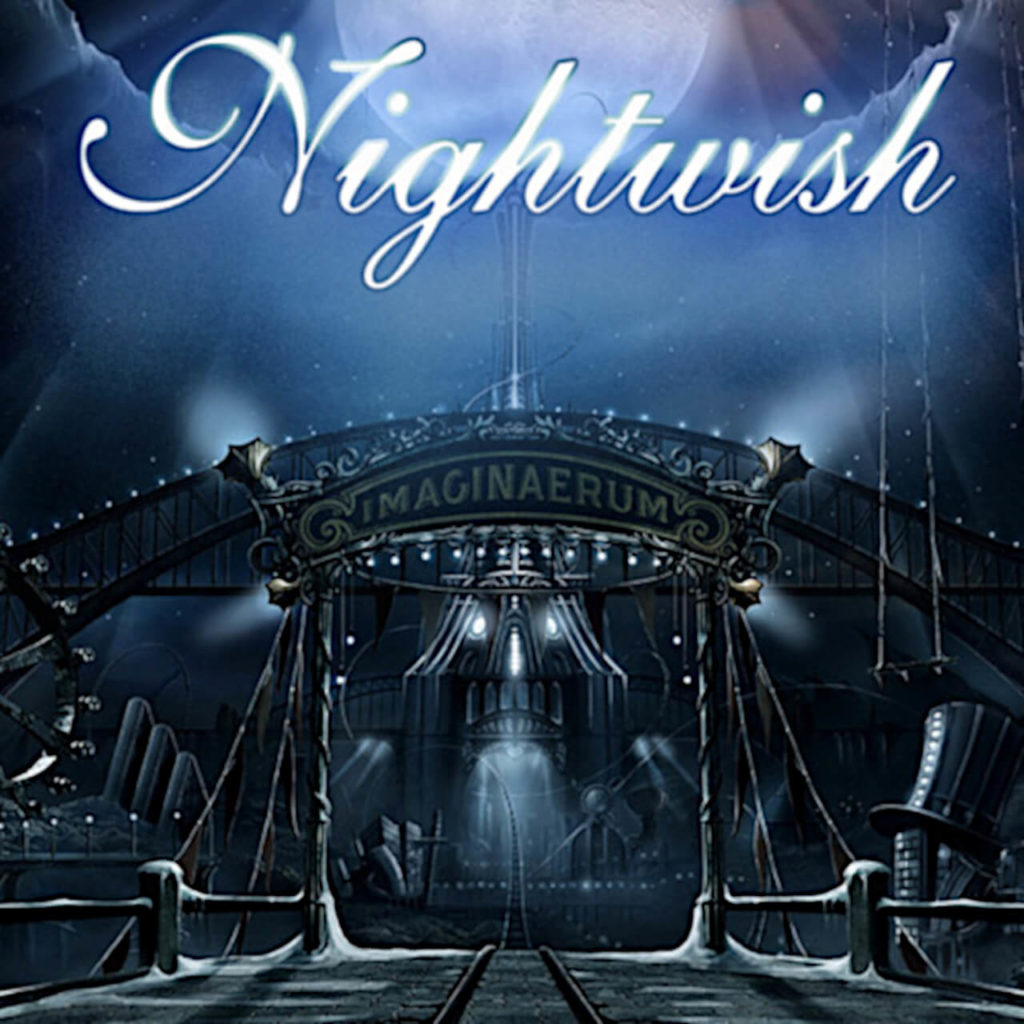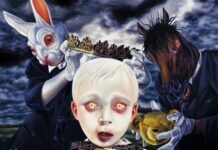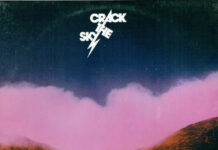In a shocking move, in 2005 NIGHTWISH parted ways with their operatic soprano vocalist, Tarja Turunen, replacing her with Anette Olzon. The first album released with Olzon in 2007, “Dark Passion Play,” to largely positive reviews despite the fan reaction to Olzon being mixed. However, “Dark Passion Play” was written before the band had chosen their next vocalist, so the songs were not written with anyone in mind. Having re-established themselves with Olzon at the front, NIGHTWISH decided to push things to the next level and released “Imaginaerum” (originally entitled “Imaginarium,” but this was changed so it would not be associated with the movie of the same name). This album promised a dark fantasy rollercoaster-ride and was released concurrently with movie of the same name. Today is the 10th anniversary of “Imaginaerum,” so what better time to look back on the album and see how it helped to evolve the band’s sound.

One of the most interesting things of note about “Imaginaerum” was that it was – at least to date – NIGHTWISH‘s last truly fantastical album. Heavily dreamy and magical, “Imaginaerum” is a mysterious abandoned carnival of an album, whereas the two more recent albums have shown a strong turn away from fantasy but towards the planet, the environment, and the beauty of nature. It is also relevant as the band’s last album with Olzon at the front, before she left and was replaced by Floor Jansen, and the last album to feature Troy Donockley as only a guest. As such, “Imaginaerum” is a pretty important album in the band’s discography that feels like the end of yet another era.
In another notable moment, “Taikatalvi” (or “magic winter,” which is also the name of a Moomin story) is the only intro song the band has ever released. Using a music-box sound and only Marko Hietala‘s Finnish vocals, this pretty, soft piece acts as a perfect start to a magical, fantastical album. It’s also the only song sung in Finnish; these treats were, in the past, kept for later in the album, so this was an intriguing change of pace. Marko Hietala notably shares the spotlight with Anette Olzon on vocals nearly equally on this album, as is seen already in Anette‘s absence from the intro. This transitions swiftly into “Storytime,” which opens on intriguing piano notes as the band join in bit-by-bit in one of those truly traditional NIGHTWISH melodies. I recall the first time I heard this song on the radio and was truly astounded and shocked by the sound in the chorus – it was unlike anything I had heard NIGHWISH do before. It took some time to adjust, but I came to realize that I wasn’t listening to the song on repeat to figure out if I liked it… I was doing it because I just liked listening to it. It’s a great single, with vibrant and creative vocals – Anette has a real banger for her debut on this album! – with just the right type of dynamics to give listeners a big rush as it pushes forward. The instrumental breaks show off fabulous drumming, glorious symphonics, and operatic choirs, which pull the listener into the climaxing final choruses. It is a wonderous package from start to finish and a great single to get listeners excited for what will come next.
If you love it when NIGHTWISH gets a little darker, raise your hand with me! “Ghost River” starts on a very slick riff that is immediately punched up by the rest of the band joining in, as Anette shows that her sweetness can carry a seed of something darker, while Marko Hietala returns with a lunatic mania in his sound – something that he has always been amazing at – before Anette takes over a gentle wailing while Marko begins singing in a way that almost sounds like he’s casting a dark spell. There’s something so wonderfully sinister in that crazed carnival feeling.
Did anyone else expect their to be a slow jazz song on a NIGHTWISH album? I know I didn’t. “Slow, Love, Slow” skipped my regular playlists back in the day because it wasn’t a metal song, which has somehow resulted in every listen being a rare and pleasant treat. While on its own it seems a strange inclusion, it fits perfectly in the story and ambience of the fever dream that is “Imaginaerum.” The piano notes at the beginning blend so darkly into the bass, as the backing ambience sets a very unsettling scene. Anette is a seductive siren, while the male vocals add some texture. The smooth jazz guitar part is also a pleasant change of pace, while the lightness to the choruses pervades despite the vaguely unsettling feeling overall. Also, can all the Anette Olzon haters please go listen to her wail at the end of this song and tell me why you hate her so much. I still get chills.
The album bounces back with the energetic crowd-pleaser, “I Want My Tears Back.” This was the second album to feature Troy Donockley, who became a full member of the band in 2013, and “I Want My Tears Back” has him forefronted on the pipes, creating a wonderful folky flavor that pervades until Anette joins in, high and sweet, until she belts it out in the chorus. The playful trade-off between Anette and Marko is so engaging, while we still benefit from the fun flare of Jukka Nevalainen (who left the band in 2014 due to insomnia) on drums. Troy is the star of this song during the instrumental parts, as all of the other instruments work to build him up. Then, in a dark and nightmarish turn, listeners enter the haunted dream that is “Scaretale,” which brings the evil side the carnival forth before the traditional Tuomas Holopainen keyboards bring further drama. There’s a second dynamic kick-up as more and more sounds join in, but the guitars get a moment in the lead before some of Anette‘s creepiest singing starts. Marko Hietala gets to take the crazed ringleader role as this disturbing ghost circus rolls onward, with the “la-laa” parts being a surprise highlight alongside the “hoo! hah!” sounds. There’s yet another twist in this ride though, as Anette returns in a witchy, cackling melody. The love of tribal drums and oriental horns can be heard at the start of “Arabesque,” which is an intriguing and mysterious instrumental track that manages to get your heart racing a bit, much like fire dancers in the live video.
The album slows down a bit with “Turn Loose the Mermaids,” which focuses on acoustic guitar and Anette Olzon sings gently and beautifully. There’s an intriguing power to how downplayed the chorus is, building up each time until it near bursts with emotion. While I’ve heard it claimed that this is one of the weaker songs on the album, I’d argue that this is a great performance by Anette, as she holds a lower, stronger tone that contrasts nicely with her usual higher, poppier style. The addition of tribal drums again in the dynamic build-up, alongside the spaghetti western whistling and horns result in a strange and wonderous climax that is backed up by strings. The additional vocal layering towards the end, along with the Celtic strings, create a rather diverse overall feel. Sure, it’s a more downplayed song, but not everything needs to be a banger.
There’s a dramatic forward push with prominent key notes at the beginning of “Rest Calm,” which starts with some wailing from Marko Hietala and one of Anette Olzon‘s most powerful and dramatic bridges. The build-up to the gentleness form a nice dynamic contrast with the more exciting verses. Even the solos are a bit more relaxed, despite remaining quite bombastic. As Anette returns to the chorus at the end, a children’s choir take over most of the lyrics, allowing her to do some powerful wailing, with Marko also joining in. The song continues with seemingly everyone doing as they would, resulting in a powerful finish despite the slower tempo. Marko Hietala‘s notorious poppy songwriting contribution to this album comes in the form of the acoustic-led “The Crow, The Owl and The Dove.” The vocalists are again doing a lovely job of harmonizing and the lyrics have always come across as rather tender and sweet. Troy Donockley is back as well, singing in a dead Celtic language called Cumbrian (loosely translating to “go to the river, arrive at fairyland”), again, not unlike someone casting a spell.
The album begins its rise to the climax of its ride with “Last Ride of the Day,” which many share a consensus on being one of the best songs from the album (or in general), as can be seen in its popular place at the end of NIGHTWISH‘s live sets. Anette really gets to explore her range in here and it just feels like everyone is having fun – even Emppu Vuorinen‘s guitars feel like he’s fully letting loose. It’s hard to go deeper into this song – it just fucking rules on every level.
Now… where do I even begin with “Song of Myself”? This track is potentially Tuomas Holopainen‘s most underrated composition. At least in my opinion, the first half of this song is a masterpiece of dynamic force, fantastic vocals, peak-performance instruments, all on top of choirs, orchestrations, and the end of this album’s story. It doesn’t punch forward as quickly as “Last Ride of the Day,” but draws the listener in deeply as the wave of sound rises, only to soften after a few minutes. We are then treated so some dynamic instrumental parts teased in with choirs, glorious and magnificent …up until around the 7-minute mark, also known as the problem part. Here, Troy Donockley is the first to start a series of lovely poetic narrations inspired by Walt Whitman’s Song of Myself, set to ambient instrumental music. So if it’s so good, why is it the problem part? Well, because it’s a 7+ minute poetry reading attached to a 7-minute long banger of an epic. This is likely the reason that “Song of Myself” gets regularly forgotten… because it never made it onto playlists because no one wanted to keep skipping through the poetry at the end. Why, oh why, did they not simply clip this into a separate song? Well, this aside, much like with the jazz track, it always means that returning to “Song of Myself” is a treat thanks to how rarely it gets heard, so at least there’s a silver lining.
As “Song of Myself” is the album’s epic, “Imaginaerum” is therefore the outro. Much like the music score you would hear during movie credits, this 6+ minute instrumental is a medley of every other song on the album in chronological order, magically adapted to perfectly summarize the album and wrap things up. I’ve never heard one of these songs at the end of an album before, so this was a very unique treat to wrap up the album, especially as it features a lot of the most memorable melodies, all wrapped up in one. It’s a fantastic conclusion to a fantastic album.
Now, let me posit a question: what is NIGHTWISH‘s best album, objectively? Well, music will never be truly objective, but I might at least challenge listeners to consider “Imaginaerum” for this title. Why? Well, it’s shows a vibrant and beautiful evolution in both creativity and sound for the band. As mentioned, unlike “Dark Passion Play,” “Imaginaerum” was written specifically with Anette Olzon‘s voice in mind, therefore developing the vocal sound tenfold and really tapping into her capabilities in a way that I’ve never heard since. This also acts as a natural development and improvement on “Dark Passion Play.” It also tastefully bridges the gap between the eras that pre-date Troy Donockley and his addition to the full lineup, teasing in some folkier elements. “Imaginaerum” also shows a continued development away from near-religious fantasy (with a focus on angels and the like) to a more mysterious and dark fantasy, which likewise paves a path towards their current natural fantasy. In fact, it may be the last most generally accessible album before they take a slightly more progressive turn with their existential, psychedelic love of nature and the beauty of life itself, which may be a bit hard for the average person to grasp (at least without the help of some psychedelics and a walk in the woods). And finally, while we all know that Floor Jansen is a goddess who can do anything, Anette does have one strength that surpasses Floor, which is the gentleness and tenderness in her voice. Floor is too badass to ever really sound particularly vulnerable, while Anette is able to show that effortlessly, as can be seen throughout this album.
So would I declare this the ultimate NIGHTWISH album? I don’t know… but I’d at least go so far as to say it is the pinnacle of NIGHTWISH‘s sound at its most accessible. However, I daresay, NIGHTWISH‘s best album may very well still be out there, as there are few bands around who have developed their sound in such a natural and organic way. So, happy anniversary to “Imaginaerum”! We surely can’t wait for what comes next!
Tracklist
- Taikatalvi
- Storytime
- Ghost River
- Slow, Love, Slow
- I Want My Tears Back
- Scaretale
- Arabesque
- Turn Loose the Mermaids
- Rest Calm
- The Crow, The Owl and The Dove
- Last Ride of the Day
- Song of Myself
- Imaginaerum
Disc 2 includes instrumental versions of each song
Lineup
Anette Olzon – vocals
Marko Hietala – bass, vocals
Tuomas Holopainen – keyboards
Emppu Vuorinen – guitars
Jukka Nevalainen – drums
Fellow Imagineers:
- Troy Donockley – uilleann pipes (on track 5 and 13), tin whistle (on track 1, 8 and 10), vocals (on track 10 and 12), bodhran, bouzouki
- Dermot Crehan – hardanger fiddle
- Dirk Campbell – sorna
- Guy Barker – solo trumpet
- Paul Clarvis and Stephen Henderson – ethnic percussion
- Pekka Kuusisto – violin
- “The loved ones & the fellowship” – stanzas in track 12
- Kai Hahto – percussion
Label
Nuclear Blast Records / Roadrunner Records





